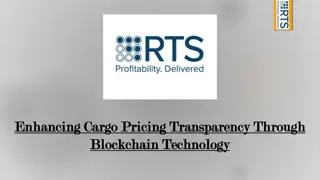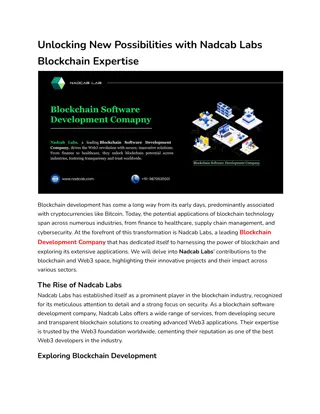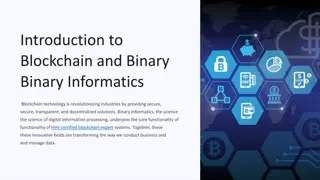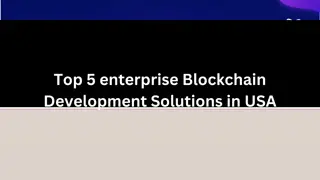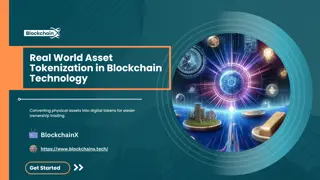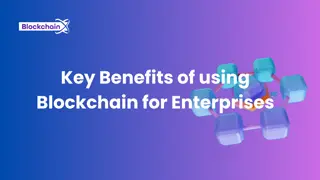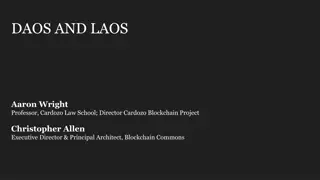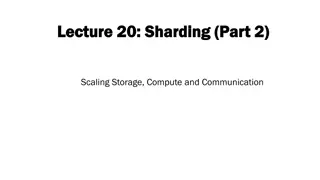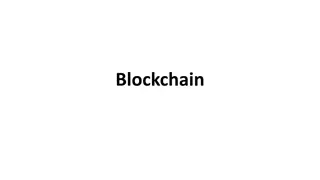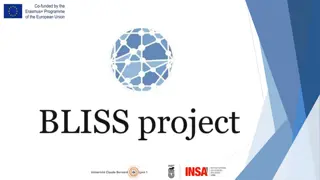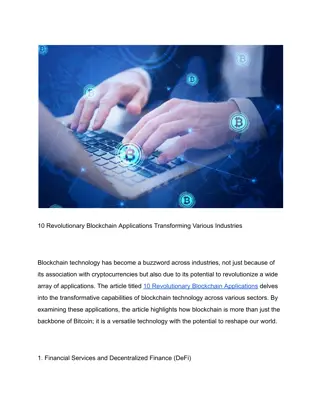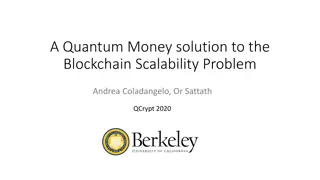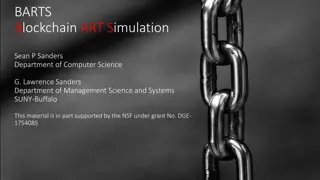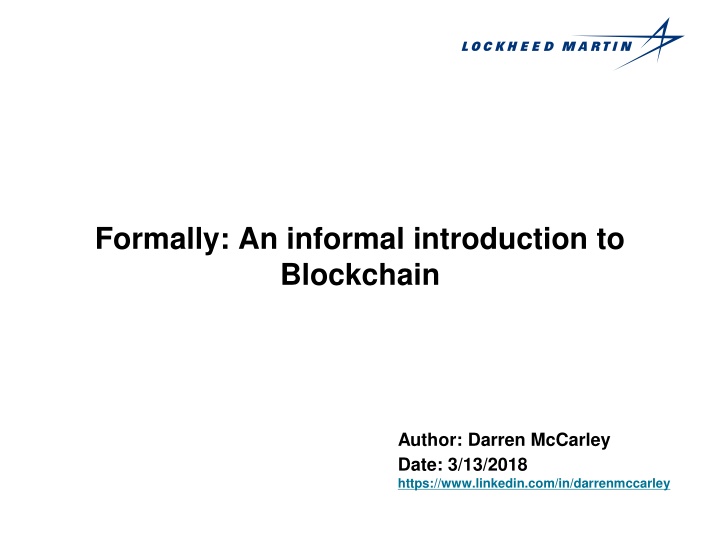
Blockchain Technology: A Comprehensive Overview
Explore the fundamentals of blockchain technology, its historical significance, and real-world applications. Learn about transactions, immutable ledgers, decentralized peers, encryption processes, consensus mechanisms, and smart contracts within the blockchain ecosystem. Gain insights into the impact of blockchain on various industries such as banking, manufacturing, transportation, and more. Understand the potential of blockchain to revolutionize data integrity, transparency, and security in the digital era.
Download Presentation

Please find below an Image/Link to download the presentation.
The content on the website is provided AS IS for your information and personal use only. It may not be sold, licensed, or shared on other websites without obtaining consent from the author. If you encounter any issues during the download, it is possible that the publisher has removed the file from their server.
You are allowed to download the files provided on this website for personal or commercial use, subject to the condition that they are used lawfully. All files are the property of their respective owners.
The content on the website is provided AS IS for your information and personal use only. It may not be sold, licensed, or shared on other websites without obtaining consent from the author.
E N D
Presentation Transcript
Formally: An informal introduction to Blockchain Author: Darren McCarley Date: 3/13/2018 https://www.linkedin.com/in/darrenmccarley
Disclaimer This is not a Bitcoin introduction. This is a high-level introduction to Blockchain technology. However, we should acknowledge that Satoshi Nakamoto (pseudonym) and his/their creation, Bitcoin, popularized Blockchain technology. (There are currently arguments that Bitcoin was not the first blockchain.) Today there are various flavors of Blockchain. This paper attempts to generalize Blockchain with samples in some of those flavors. Additional research, prototyping, and due diligence should be exercised before making any long-term decisions. Lastly, it is the opinion of the author, no single Blockchain solution will fulfill all needs. As many of the Blockchain technologies are paradigm specific, one should educate themselves on when and how to implement a Blockchain solution. Perhaps more importantly, when NOT to implement a solution. 2
A Brief history of Blockchain On October 31, 2008, Satoshi Nakamoto released the Bitcoin White Paper outlining a purely peer to peer electronic cash/digital asset transfer system. This is the first popular implementation of Blockchain and is attributed as birthing today s Blockchain industry. Since then, additional Blockchains have been popularized, Ethereum, various Hyperledger project solutions, as well as numerous others including Blockchain like solutions such as GuardTime s KSI products 3
What is Blockchain? Blockchain is a system comprised of.. Transactions Immutable ledgers Decentralized peers Encryption processes Consensus mechanisms Optional Smart Contracts Let s explore these concepts 4
Transactions As with enterprise transactions today, Blockchain is a historical archive of decisions and actions taken Proof of history, provides provenance Notable transaction use cases Land registration Replacing requirements for research of Deeds (Sweden Land Registration) Personal Identification Replacement of Birth/Death certificates, Driver s Licenses, Social Security Cards (Estonia) Transportation Bills of Lading, tracking, Certificates of Origin, International Forms (Maersk/IBM) Banking Document storage, increased back office efficiencies (UBS, Russia s Sberbank) Manufacturing Cradle to grave documentation for any assembly or sub assembly Food distribution Providing location, lot, harvest date Supermarkets can pin point problematic food (Walmart) Audits Due to the decentralized and immutable nature of Blockchain, audits will fundamentally change. Demo - https://anders.com/blockchain/blockchain.html 5
Immutable As with existing databases, Blockchain retains data via transactions The difference is that once written to the chain, the blocks can be changed, but it is extremely difficult to do so. Requiring rework on all subsequent blocks and consensus of each. The transaction is, immutable, or indelible In DBA terms, Blockchains are Write and Read only Like a ledger written in ink, an error would be be resolved with another entry 6
Decentralized Peers Rather than the centralized Hub and Spoke type of network, Blockchain is a decentralized peer to peer network. Where each NODE has a copy of the ledger. Legacy Network Centralized DB Blockchain Network Distributed Ledgers 7
Encryption Standard encryption practices Some Blockchains allow for BYOE (Bring Your Own Encryption) Only as good as the next hardware innovation All blocks are encrypted Some Blockchains are public, some are private Public Blockchains are still encrypted, but are viewable to the public, e.g. https://www.blocktrail.com/BTC Private Blockchains employ user rights for visibility, e.g. Customer Writes and views all data Auditors View all transactions Supplier A Writes and views Partner A data Supplier B Writes and views Partner B data 8
Consensus Ensures that the next block in a blockchain is the one and only version of the truth Keeps powerful adversaries from derailing the system and successfully forking the chain Many Consensus mechanisms, each with pros and cons Consensus Mechanism Proof of Work Proof of State Proof of Elapsed Time Proof of Activity Proof of Burn Proof of Capacity Proof of Importance And others . 9
Smart Contracts Computer code Provides business logic layer prior to block submission Blockchain Bitcoin Ethereum Hyperledger Smart Contracts? Language No Yes Yes Solidity Various GoLang, C++, etc, depends Others Depends Depends 10
Blockchain Capabilities All parties agree to network verified transaction A shared ledger technology allowing any participant in the business network to see the system of record (ledger) Ensuring appropriate visibility; transactions are secure, authenticated & verifiable Business terms embedded in transaction database & executed with transactions Blockchain Essentials 1. A business problem to be solved That cannot be solved with more mature technologies 2. An identifiable business network With Participants, Assets and Transactions 3. A need for trust Consensus, Immutability, Finality or Provenance Negative Indicators, Anti-Patterns 1. Need high performance (millisecond) transactions 2. Small organization (no business network) 3. Looking for a database replacement 4. Looking for a messaging replacement 5. Looking for transaction processing replacement 6. Process and metrics are not clear within the ecosystem 7. Value, velocity and/or variability are not present 11
Additional Resources Bitcoin White Paper Satoshi Nakamoto Blockchain Demo Anders Brownworth Videos Blockchain for Business - An Introduction to Hyperledger Technologies - edX.org Ethereum White Paper Guardtime Blockchain like official site Hyperledger official site - Linux Foundation IBM Blockchain for Business IBM Dev Center IBM Blockchain Essentials Course IBM Dev Center IBM Blockchain Foundation Developer IBM Dev Center Many more and pages are always changing 12



